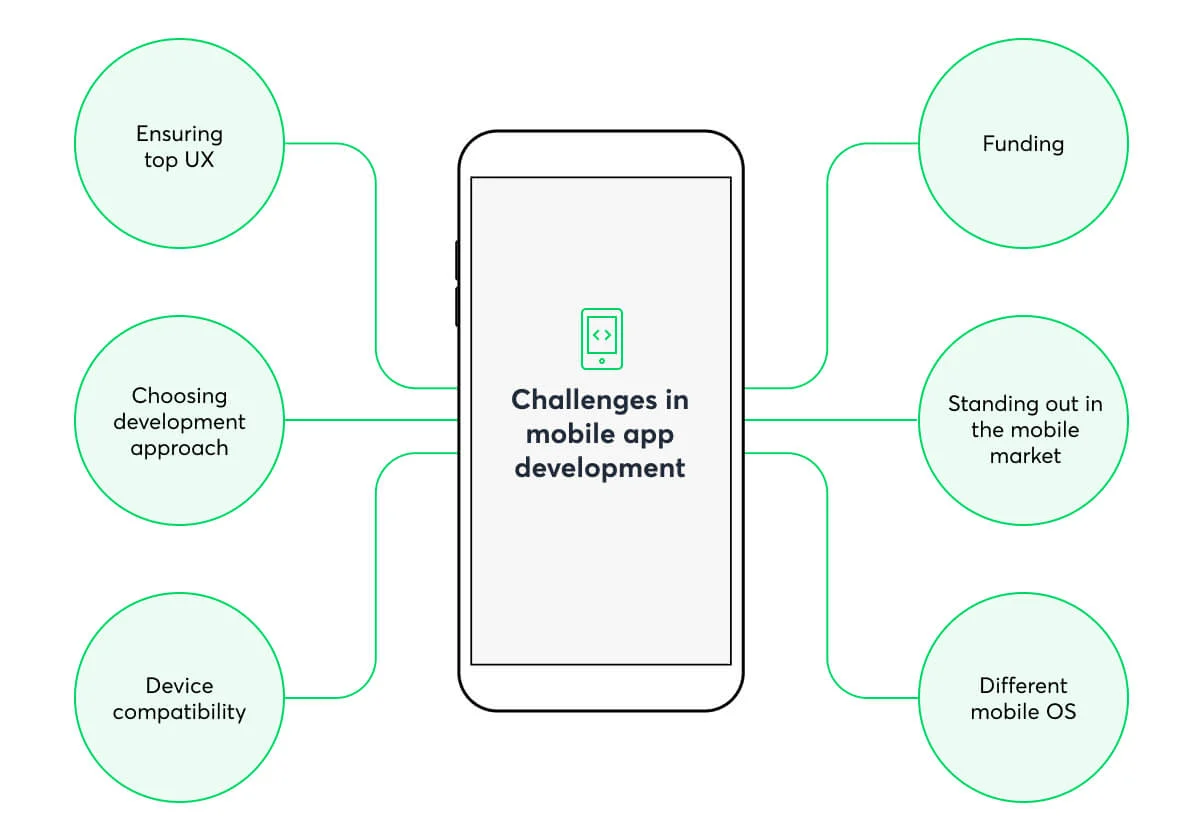Biggest Mobile App Development Challenges
Technological advancements are driving rapid innovation, with new tech startups emerging regularly to meet consumer demands fuelled by fresh app ideas. This is particularly evident in the smartphone app market, as mobile devices become indispensable in daily life.
Businesses across industries invest heavily in mobile app development, striving to stand out as leaders in a competitive landscape. Apps have become essential communication channels, connecting businesses with their customers effectively.
However, navigating the complexities of mobile app development, particularly for Android, is no small feat. Challenges such as keeping pace with evolving Android trends, crafting intuitive UX designs, managing device fragmentation, and seamlessly integrating third-party APIs can pose significant hurdles.
What are the challenges in developing mobile applications?
There is a large range of different mobile application challenges that an app developer will face throughout the development lifecycle. This ranges from choosing the best approach to developing the app, to creating an app that is good enough to stand out in the competitive market.
So, what are the main challenges of mobile app development? Let’s look at the key mobile problem list.
Choosing the Best Development Approach
When starting app development projects, the first matter to consider is choosing the best app development technology approach.
The real challenges in mobile app development are making sure you decide on the right decisions in the early stages so that you create the best possible app for your customers. So let’s take a look at some of the development approaches you can take to overcome your mobile app challenges.
Native app development
The first approach is known as native app development. This type is where you develop an app using right tools specific to a certain mobile operating system (OS). The android app development process involves challenges and complexities such as integrating third-party APIs, ensuring compatibility across different Android versions and devices, and maintaining user engagement while implementing futuristic features under tight deadlines. The native approach comes with a range of advantages.
One of these is the fact that native apps often perform much better than other types of app development and are often extremely reliable and safe, helping meet any mobile development trend.
However, if you use the native approach, and decide to put your app in an Android mobile app market, you will have to develop it all over again if you would like your app to be shown in another marketplace.
Cross-platform app development
The second approach is called cross-platform development. Just like the name suggests, this development type is perfect for those who are looking to put their apps on a range of different app marketplaces. Developing Android apps comes with its own set of challenges, including security issues, app visibility, device fragmentation, and integration of third-party APIs.
Although it sounds good on paper, there are numerous issues with cross-platform development. Firstly, there is a huge dependency on the type of framework that is used to develop the app. As you will have to do all the work on these development platforms that have a distinct lack of features, you need to ensure it will have everything you will ever need for the app you are developing.
There are simply many more features that can be worked on and at much faster speed in native development than in cross-platform. Because of this, teams working on the app development will often need to work on cross-platform, as well as iOS and Android native development, making the whole process much more costly and time consuming.
Hybrid app development
You can also go for hybrid mobile development. This way, apps are developed using standard forms of coding, like Javascript and CSS that have higher performance than cross-platform apps.
Hybrid applications consist where elements from native apps and web applications are combined. They are web apps that have been placed inside a native app shell. This means that mobile app developers require only one source of code for the app and it will still be usable on multiple platforms. However, the unfortunate drawback is that a lot of native UX is sacrificed as a result, along with all the great features in native development that hybrid apps just can’t replicate.
Choosing the right development approach is one of the crucial decisions in creating mobile products. Be mindful in researching these different types and decide which one is better for you, based on your needs and goals.
Ensuring great User Experience
When developing an app, designing a user interface that provides a great user experience without faults is one of the most important processes and one of the crucial application development challenges faced by UX designers and programmers. This can often be difficult, as it needs to meet the best usability practices or it simply won’t be used as much as competing apps having better user experience.
Great user experience is one of the biggest mobile app design challenges when making an app. Ease of use, and loading times are just some of the factors that are imperative in users’ eyes for them to carry on using them otherwise they may go for another mobile product.
Device compatibility and screen size
One of the key factors in mobile UX design is ensuring the app works well on a range of different mobile devices. If it is not compatible with certain popular devices and the screen size is not catered to this could make the user experience much worse.
This is often one of the toughest challenges faced while testing mobile applications as there are many different devices and screen sizes, so ensuring the app is compatible with all of them can be difficult.
Although it is important to develop apps with accessibility as a main focus, there are no special requirements that need to be met.
Different mobile operating systems
There are many iOS, Android, and Windows app development challenges that developers face when trying to provide the top-notch user experience. Specifically, the Android OS presents unique challenges such as fragmentation, security vulnerabilities, and the need for compatibility with various device configurations and versions. Developers have to ensure that the app is working well on every operating system to ensure a high-quality user experience.
Standing out in the mobile apps market
Mobile apps are extremely popular, and as such, the mobile market is extremely competitive. One of the main challenges is app visibility in a crowded market. So how do you develop an app that stands out from the crowd?
One of the biggest mobile app development challenges is promoting the app. There are several ways to do this.
One of them is making it discoverable. If people can easily find it on an app marketplace, they are much more likely to download it. If you’ve created a high-performing app that has a great user experience but no one can find it, you won’t reach your business goals.
Mobile Product Management
A digital product manager typically manages all development phases of the app during its lifecycle.
In short, they prepare the app, making it ready for a smooth launch by gathering all the necessary user data, getting relevant feedback and researching and creating a relevant go-to-market strategy.
They also construct a product vision and product direction, where they create long term goals that they want the product to achieve, and go about finding a strategy to achieve this.
As well as this they ensure to continuously enhance its features by testing for bugs, conducting A/B testing and many other types of tests to ensure smooth launching, with the aim of providing the user with the best experience possible.
During this time, an abundance of analytical data is collected and analyzed by project managers to find out the app’s best-performing features and best-suited target audience. From using user feedback to A/B testing, data collection and analysis helps with increasing the company’s return on investment.
Employee trust and privacy
The first issue you must address when managing the businesses’ mobile tech stack is employee understanding. All companies rely heavily on their staff to ensure meeting targets within the organization. Therefore, when transitioning over to a new platform, staff must be trained to reduce any misinformation that can occur.
Trust plays a major role in the staff onboarding process. If privacy concerns and other crucial elements aren’t discussed by management, then employees may become wary about promoting your app to customers.
Missed scaling opportunities
A common mistake during app management is not identifying areas to improve. Organizations often abandon app development after the launch.
However, once you generate the feedback, there is always potential to enhance the mobile software to reach beyond current targets and enhance satisfaction amongst customers. Whether it be adding additional services or making the platform easier to navigate.
Keeping security tight
New threats present themselves through the use of apps and other technologies. Great attention by the companies’ IT security team when managing apps is required to monitor and optimize app performance to prevent any data leaks or malware attacks.
Security walls must be tested rigorously and maintained constantly otherwise the outcome can be disastrous. Some apps may even be removed from the app store, whether it is Google Play or the App Store. This is one of the crucial mobile application development challenges. Always implement the best practices to ensure users’ data are completely safe and you won’t have to deal with data breaches.
Getting new or existing customers to adapt
For long-established companies that have recently released an app, or for new tech startups that are targeting a hard-to-reach demographic, getting users to switch to this platform over others can cause issues.
To overcome mobile app challenges, you should invest your time into creating informational content that you can distribute through pre-existing channels to highlight the benefits of using this platform. This includes funnels that are already being used to communicate with returning customers or targeting new ones.
What are the challenges of enterprise application development?
Streamlining business processes can help greatly in increasing the productivity and efficiency of your company’s daily operations. However, if you don’t carefully examine certain aspects, it can lead to many problems in app development.
Adaptability during development
For enterprise applications to work as intended, analysts and system architects must use relevant data. Therefore, if new forecasts provide an insight that requires changes to ensure overall efficiency, developers must be ready to alter their approach.
The team tasked with developing an app will be crucial if this happens. Willingness will determine if the end-product will be suitable for the internal company needs or becomes ineffective.
High cybersecurity standards
An enterprise app typically involves a complex structure. This contains all the necessary services allowing the company to function. As new updates clear up, and gathered private information increases, the protection of these assets should be a top priority.
Companies all over the world deal with insufficient security on their internal systems at great expense. Cyberattacks are common and lead to enormous costs, and have even caused some businesses to go bankrupt, creating development challenges for the whole industry.
To stay protected against mobile security issues, consider the following factors during your development process:
- Different access levels to gain confidential information
- Back-up data systems in place
- Advanced anti-malware software built-in
- All data that is encrypted
Integration with other systems
Enterprises usually consist of various systems that help meet their daily operational needs. When developing a new application, it’s likely that your enterprise app is integrated with other systems to optimize performance and keep it user-friendly.
To prevent these issues, your development team must consider possible integrations during the early stages. This way, plans can be put in place to ensure all required systems integrate without complication. Sometimes, the solution to this may be that an ERP system should be created to deal with backend challenges.
Finding the right mobile developers
It is challenging to find the right app developers with the skills needed when creating enterprise applications. Hiring experienced Android app development companies is crucial to navigate development challenges and ensure the creation of functional and trendy apps. For companies in need of customized solutions, great industry knowledge is a must-have to ensure there aren’t any problems during the process.
The best approach is to find an external mobile development partner with experience in your branch and wouldn’t be stalled by niche relevant processes needed.
Mobile apps development challenges – key takeaways
We’ve covered many important tips during the development of mobile apps. Businesses that take note of ways to reduce mobile app problems, therefore, ensuring the right outcome is achieved will benefit significantly. Getting support in developing mobile apps can be a determining factor in your mobile app success.
The way this is achieved is through the use of mobile product management. It is an essential part of the mobile development process to ensure mobile applications achieve their fullest potential.











